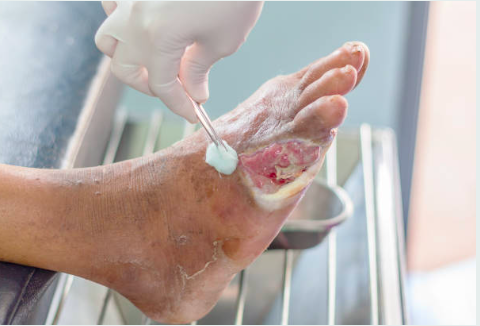Published date: 18-11-2022
Pillay (patient’s pseudonym) had just returned home from his travels overseas when he noticed a wound on the side of his pinky toe on the left leg.
Initially thinking lightly of it, he assumed it was just another injury caused by excessive walking in a pair of uncomfortable shoes. “The skin just came off, maybe because my shoe was tight,” he said.
So he treated the wound himself by applying ointment and covering the affected area with a plaster.
The incident occurred eight years ago. To his dismay, the condition worsened and around three months after, the wound had turned hard and dark.
On top of that, he started developing pain in his left calf. The pain was so unbearable that he couldn’t even bring himself to walk. At that moment, Pillay knew he had to see a doctor.

Cutting down on amputation
He visited a specialist centre and that’s where he found out that the wound on his pinky toe was infected, causing pain throughout his leg.
It was in such a dire state that the doctor advised Pillay to amputate not only his pinky toe, but his fourth toe, as well, as the infection had spread to that region. Pillay agreed.
A few months after the procedure, he noticed his third toe beginning to darken in a similar manner as his previously amputated toes.
This time he immediately called up the doctor for a check-up. To avoid the infection spreading to Pillay’s second toe and beyond, the doctor recommended a below-knee amputation.
That was something Pillay couldn’t agree to. He and his wife decided to seek a second opinion. They visited Dr. T. Moses Orthopaedic Specialist Clinic.
Instead of carrying out a below-knee amputation, the doctor at this clinic advised amputating the second and third toe, since the infection had already seeped into both areas.
He also offered Pillay a series of antibiotic treatments to clear the infection, which the doctor pointed out was being triggered by Pillay’s diabetes. Minimizing carbohydrates and sugar in his diet to manage the diabetes was another one of the doctor’s orders.
Pillay followed this advice and now six years on, Pillay is comfortably walking with one toe on his left leg.
Managing diabetes and keeping clean feet
In his late 40s, Pillay has been living with diabetes ever since his 30s. Patients who have had diabetes for a long time are more prone to diabetic wound infection.
The condition is also known as a diabetic foot ulcer, as the infection is usually confined to the feet. When a diabetic patient simply pricks his or her foot with a staple or in Pillay’s case, a shoe bite, it could lead to a chronic ulcer that does not heal.
This kind of foot ulcer could also be the first presentation of diabetes for the patient.
Diabetic patients have a higher propensity to develop such severe wounds on their feet and toes because the region has a lower blood supply and reduced sensation due to longstanding diabetes.
“So we should look at how to prevent this from happening rather than how to treat it,” said the doctor.
Steps patients’ can take to reduce the likelihood of a diabetic wound infection include:
Decrease carbohydrate and sugar intake to control their diabetes
Clean their toes and soles of the feet daily
Wear comfortable shoes
Check the feet regularly for any cuts and wounds
“I know it can be difficult to do that, but you can see the difference the moment you change your lifestyle,” added Pillay.